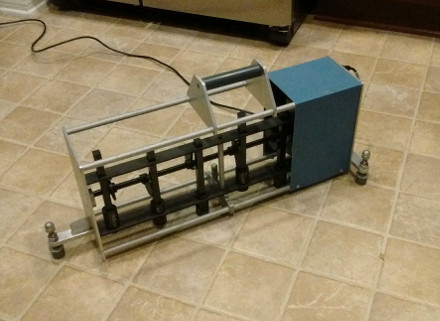Condo and Building Sound Transmission (FSTC, NIC) and Impact (FIIC, ISR) Testing
Noise Monitoring Services provides building acoustic testing services for residences, offices, condos, houses and other structures. Our acoustical consultants are experienced in the measurement and prediction of sound and impact ratings.
We can perform the following acoustical tests:
Need to discuss your project with an acoustical consultant?
For a free, no-obligation quote, get in touch with our team.

Acoustic tapping machine used for ISR/FIIC testing
Residential Sound Testing FAQ's
1How does the residential acoustic testing process work?
The ISR/FIIC testing (floor impact testing) is performed by placing a 'tapping machine' on the floor of the unit being tested. Four tests are performed with the machine in slightly different positions on the floor. The sound level is measured in the unit below and a FIIC rating is calculated from the measurement data.
For the NIC/FSTC test a loudspeaker is used to play white noise at a high level in at least two locations in one of the units. The sound level is measured on both sides of the floor-ceiling assembly or wall being tested. The NIC (FSTC) rating is then calculated from the measurement data.
2How long does the testing take?
Assuming we're performing both the FIIC and NIC tests for a single room, it will take about one hour to perform the testing. If tests are required in multiple rooms then the testing will take longer.
3How many rooms will need testing?
Most residential complexes just require testing to be performed in a single room. We usually perform the test in the largest room (eg. living room). However, we recommend that you confirm the type and number of tests that will need to be performed with the HOA beforehand to avoid us having to return for a second visit.
4Will the test damage my floor?
The equipment we use is unlikely to damage your floor. We've never seen damage to wood or laminate flooring. However, we tend to be careful in choosing a suitable location when testing on stone or tile floors as the tapping machine can occasionally chip the surface.
5When will I get the results? Will I get a report?
We can usually supply the results within one to two days of performing the tests. We will provide a report to you containing the results that you can then submit to your Homeowners Association.
6What are the ratings my floor needs to achieve to pass the tests?
The State of California Building Standards Code (Title 24) requires floor-ceiling assemblies to achieve a minimum FIIC rating of 45 and a minimum NIC rating of 45 when field tested. We often perform the tests at residential complexes where the CC&R's require higher ratings. This can often be in the range 50 to 55 for both ratings. We highly recommend you check with the HOA or review the building CC&R's to determine the required ratings.
7Will my floor pass the tests?
Whether or not your floor passes the ISR/FIIC test depends on the floor surface, whether an underlayment is installed, and the acoustic properties of the supporting structure. To give your floor the best chance of passing, we always recommend that an underlayment is installed.
The NIC rating is highly dependent on the structure of the building. If the floor does not achieve the required rating, remediation may not be possible. In these cases we will be happy to supply a letter stating this.
8Can you recommend an underlayment product?
Our testing in residential units has shown that an underlayment can improve the FIIC rating of a floor-ceiling assembly by several points. We don't have a specific product recommendation. We've found little difference in the measured FIIC rating of products we've tested side-by-side. Generally we're quite skeptical of manufacturer FIIC rating claims for their underlayment products. We have found that thicker products can have a better performance at high frequencies than thinner products; however, we've also found the FIIC rating of an assembly is usually limited by its performance at low frequencies and so a thicker undelayment does not necessarily mean an increased chance of passing the test.
We don't have test data of our own showing any one underlayment product results in significantly higher FIIC ratings than any other. We'll refer you to your floor underlayment dealer to make a product recommendation for your unit.
